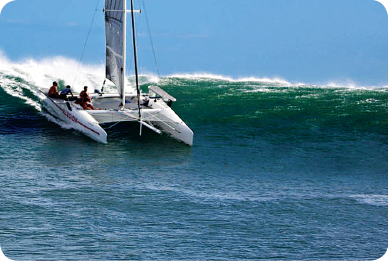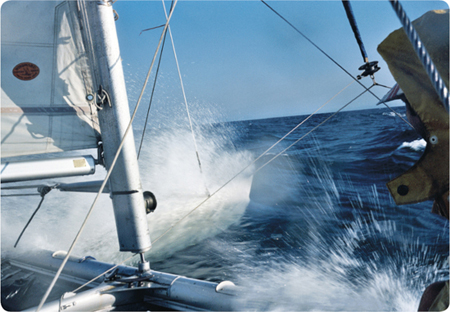
These guys look to be having a fun time in the Ala Moana channel. Jamie Ballenger
Sailing and Surfing

These guys look to be having a fun time in the Ala Moana channel. Jamie Ballenger
I’ve had some great adventures on some of the most efficient and radical sailing boats out there. Luck again got me right in on the leading edge of that.
Today, people are sailing around the world faster than any power vessel has; that’s a huge accomplishment! A testament to the engineering and human stamina involved. To be at that high a level for that long a period of time and to pull it off is amazing. It’s like stepping onto the moon.
There are a lot of parallels between contemporary surfing, towing, slab riding, and transocean sailing. The principles in the head and in what it takes to do it are similar. You just don’t go out there on an 80-foot boat and throw yourself into 100-foot wave and pull that off.
I know they’re riding huge waves towing in. They’re riding slabs that make me want to throw up. Surfing in the last 10 years has developed to an incredible level, but aspiring to a 100-foot wave in midocean with no helicopter or Jet Ski around to save you and no mommy to call is an entirely unique experience. You’re riding an 80-foot surfboard, a self-propelled surfboard, and you’re towing yourself into these big ocean waves.
Surfing is fairly simple: It only has a few elements. These high-tech sailboats have more elements involved to make it possible to do what they do – to ride a 100-foot wave on a big boat like that. It’s the human element that connects sailing and surfing and the human element that keeps those big boats together.
There is so much more to it than just steering the boat. You have to constantly walk around on those boats with a tool apron on and tighten bolts; you’ve got to keep it all together. The loads are phenomenal.
I had a great sailing and surfing experience on Double Bullet in one of the Transpac races. Double Bullet was a big catamaran around 75 feet long that had no cabin, but the hulls were big enough to sleep in. Bullet was cold-molded – a really beautiful boat, beautiful hulls – but the rig, with its 100-foot mast and huge winches, left a lot to be desired. It was probably the most dangerous boat I’d ever sailed on because of the rig. It had these death triangles where if a fitting gave way, you’re in the middle of a crossbow. Cur-rack! something breaks, and you might get a shackle imbedded in your head at a zillion miles an hour.
I think it was 35 feet wide; you could imagine when flying a hull with that wide a boat that the loading on the rig was just unbelievable. This is a big boat, big gear, and fast. At 20 knots, you’re thinking, “Is something dragging? Have we got kelp on the rudders, what’s going on?” When you hit 30 knots, you’re thinking, “Oh, OK, now we’re finally moving. This boat was easily capable of breaking the existing record and setting a new one.
On the afternoon of day four of the race, we came upon a line squall that looked like a big-walled, point-wave at Rincon: an endless black and gray line that was 400 or 500 feet high. It was this huge wave. At the same time, we had this big ocean swell behind us and just the right wind velocity. We felt like we were on a 75-foot surfboard, and we were riding this line squall.
Usually, you sail by feeling the subtle changes in wind direction and velocity – but this one you could see; it was a visual wave. We knew where we were in relation to it, and we rode it like we were on a surfboard: off the bottom up into the wave, then release, driving off the wave, and gaining speed. As the apparent wind builds up and moves forward, you can trim around the sections and get in the barrel. It’s surfing at a very high level, and it lasted for hours.

Malia at speed. Mickey Muñoz